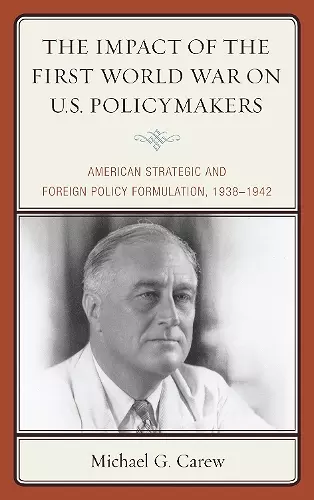The Impact of the First World War on U.S. Policymakers
American Strategic and Foreign Policy Formulation, 1938–1942
Format:Paperback
Publisher:Bloomsbury Publishing PLC
Published:28th Mar '17
Currently unavailable, and unfortunately no date known when it will be back

The Impact of the First World War on U.S. Policymakers: American Strategic and Foreign Policy Formulation, 1938–1942 is designed to recount the formulation of foreign and defense policies through an examination of the background of the policymakers, with specific emphasis on the World War I experience. The introduction provides an analysis of the literature of the history of this American World War II policy formulation. The events and factors that led to the reorientation of priorities in 1938-1939 are examined. From that base, Michael Carew reviews the unfolding events of the European and Japanese degeneration into war through the spring of 1940, and their perception for the American policy-makers. He also recounts the tectonic shifts of the subsequent eighteen months and the scramble for an American response. The immediate consequences of Pearl Harbor brought the policymaking to a crisis, and the Casablanca conference of January 1943 signified the completion of the formulation of American foreign policy and naval-military strategy. Carew emphasizes the leadership of President Roosevelt and his cadre of planners in the policy formulation realm, the assertion of leadership of the alliance, and Roosevelt's specific tasks in managing the American war effort. These presidential tasks included the industrial mobilization of the American economy, the domestic political leadership of the war, the persuasion of the alliance to the propriety of American policy, and the defeat of the Axis.
Carew examines the middle years of FDR’s presidency. Whereas other scholars have criticized FDR's leadership during these years, Carew considers these Roosevelt's most effective years because the president 'recalibrated the priorities of his administration' to meet challenges from abroad. The historiography of this period is more complex than Carew claims, but he presents a competent, textbook-style study of Roosevelt’s policies from 1938 to 1942, making references to FDR's naval expertise. FDR was determined to avoid Wilson’s mistakes, particularly the lack of preparedness that hampered the US war effort in 1917. Roosevelt worked in these middle years to convince the US public to aid those fighting the Axis and to mobilize the US economy to make the necessary supplies while increasing the strength of the US military. During this time, he also crafted a new US military and defense strategy, one designed to achieve total victory over the enemy. It is this strategy that Carew analyzes. After Pearl Harbor, FDR undertook to lead the allied coalition and ensure a postwar world based on US principles, a task Carew claims FDR completed with the 1943 Casablanca Conference. Carew's connections between the two wars will interest nonspecialists. Summing Up: Recommended. Lower- and upper-division undergraduates; general readers. * Choice Reviews *
In the year of the centenary of the outbreak of the First World War, Michael G. Carew’s analysis of the conflict’s impact on American thinking a generation later is an insightful and most welcome addition to the literature on Franklin D. Roosevelt’s administration. -- J. Simon Rofe, SOAS, University of London
ISBN: 9780739198926
Dimensions: 231mm x 151mm x 26mm
Weight: 513g
336 pages